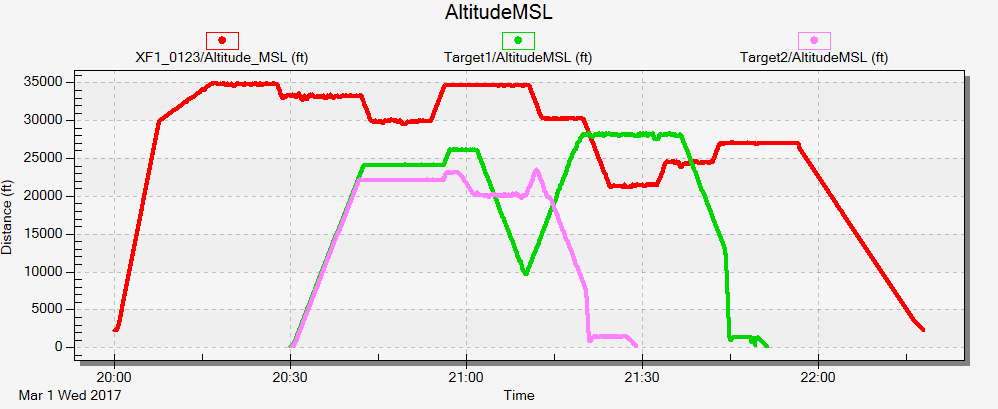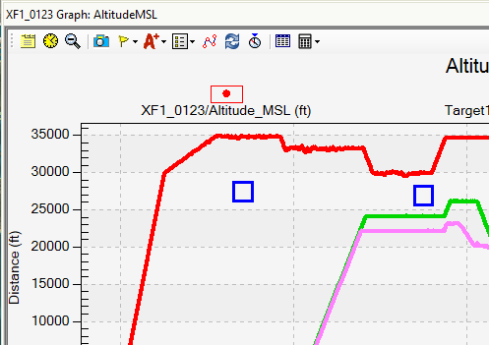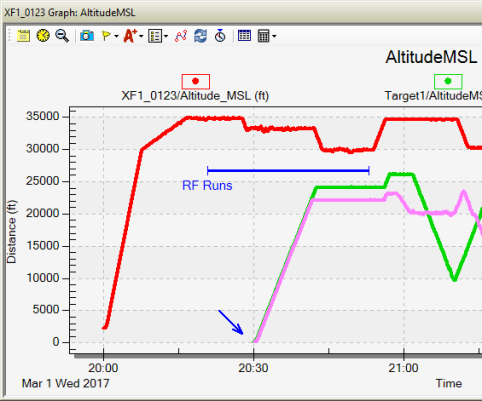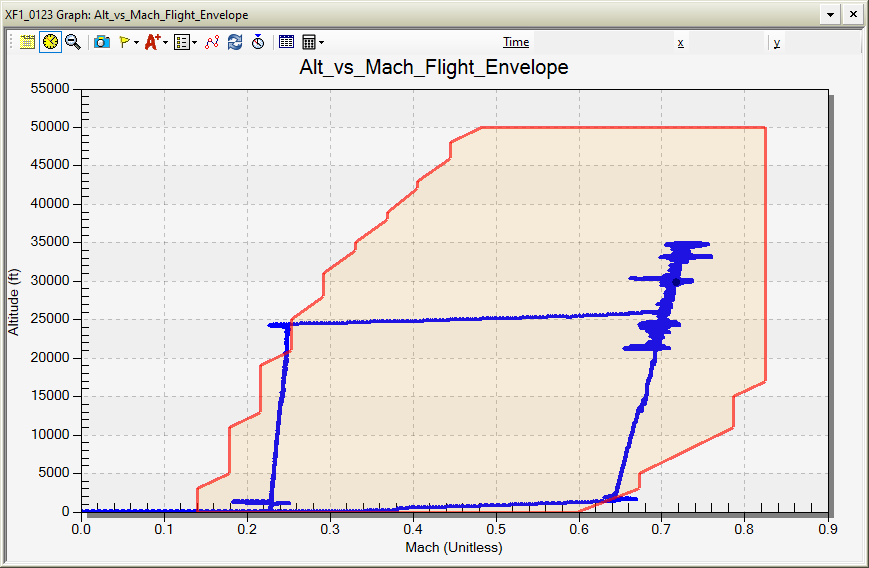STK Enterprise
You can obtain the necessary licenses for this tutorial by contacting AGI Support at support@agi.com or 1-800-924-7244.
Capabilities covered
- Test and Evaluation Tool Kit (TETK)
- STK Pro
- Analysis Workbench
Adding link lines
- In the Flight Analysis Tool toolbar, click the Draw Link Lines (
 ) button.
) button. - Name the Link Line RangeToShip.
- Click the ellipsis (
 ) under Contour.
) under Contour. - Click the Data Element button (
 ).
). - Expand XF1_0123_To_Ship_QuickLook and select RangeFromShip.
- Click .
- Under Contour Levels, click the button to auto populate the Start and Stop fields.
- Click to add the levels to the Levels table, then click
- Click the point buttons (
 ) to set the Start Point to the XF1 center and the End Point to the Ship center.
) to set the Start Point to the XF1 center and the End Point to the Ship center. - Click .
You will see a line drawn between the aircraft and ship that is colorized based on the range distance of the aircraft to the ship as it flies along the route.
Adding vectors
The Vector tool allows a user to create vectors from external data sources. If the source data is array-structured, the Vector tool automatically creates all of the array-indexed vectors.
- In the Flight Analysis Tool toolbar, click the Create Vector (
 ) button.
) button. - Click to close the message about not have any vector mappings. You will create one soon.
- Name the vector ToShip.
- Click the plus button (
 ) to create a new vector mapping.
) to create a new vector mapping. - Name the Vector Mapping NED_Ship.
- Confirm the Vector Representation is set to Cartesian.
- In the Vector Component Reference field, click the axes button (
 ) and choose XF1_0123 NorthEastDown.
) and choose XF1_0123 NorthEastDown. - From Ownship.csv, add the Ship North, Ship East, and Ship Down elements as the X, Y, and Z properties.
- Click .
- Verify that the frame object is set to the ownship XF1_0123.
- Click on the Vector panel.
- Zoom To XF1_0123 ownship. Animate the scenario; you will see the vector only during the RF runs.
This vector name has to be a unique name, and cannot be the same as any installed vectors. To check this, open Analysis > Analysis Workbench, and go to the XF1_0123 aircraft. Ensure no vectors under My Components, Vectors, or Installed Components have the same name. Close the Analysis Workbench.
You may get an error message saying Row 3 contains invalid data because the data only exists during the RF runs and is not continuous. Click to suppress this data.
Creating a new point
It may be difficult to see the vector with the Quick Look vectors displayed. You will create a new point at the nose of the aircraft to display the vector.
- From the STK toolbar, select Analysis > Analysis Workbench.
- Select XF1_0123 and click the Create new Point button (
 ). Define the following properties:
). Define the following properties: - Click , then close the Analysis Workbench.
- In the ToShip vector properties window, under Display Origin, click the point button (
 ).
). - Double-click the Nose point.
- Click .
- When asked to replace or update the vector, click .
- Save your scenario.
| Field | Value |
|---|---|
| Type | Fixed in System |
| Name | Nose |
| Fixed Point Type | Cartesian |
| X | 8 m |
| Y | 0 |
| Z | 0 |
| Reference System | XF1_0123_Body |
The vector now displays at the nose of the aircraft.
Adding graphs
- In the Flight Analysis Tool toolbar, click the Graph Flight Data (
 ) button. You may need to click Toolbar Options to display the Graph Flight Data button.
) button. You may need to click Toolbar Options to display the Graph Flight Data button. - Name the graph AltitudeMSL.
- Select the Use Time on X Axis check box.
- Click the data element button (
 ) next to the Y metric column.
) next to the Y metric column. - Expand Ownship.csv, then choose Altitude_MSL and click .
- Click the plus button (
 ) to Add a Line Segment.
) to Add a Line Segment. - Click the data element button (
 ), in the new row, expand Target1.csv, then choose AltitudeMSL.
), in the new row, expand Target1.csv, then choose AltitudeMSL. - Click the plus button (
 ) again to Add a Line Segment.
) again to Add a Line Segment. - Click the data element button (
 ), expand Target2.csv, then choose AltitudeMSL.
), expand Target2.csv, then choose AltitudeMSL. - Change the Y Units to ft.
- Click to generate the graph with the Ownship, Target 1, and Target2 MSL altitudes in a single graph.
- Click the Toggle Legend button (
 ), expand Legend, and choose Show/Hide to see which color is which object.
), expand Legend, and choose Show/Hide to see which color is which object.

- Close the graph and close the graph properties window.
Using graph annotations
Graph annotations can be a helpful way to better communicate key segments of data. There are various shapes, text, lines, best-fit curves, and min and max boundaries that can be added to any graph.
- Keeping the AltitudeMSL graph open, click the Annotations button (
 ), select Span, and click Horizontal.
), select Span, and click Horizontal. - Using the image below as a reference, do an initial click and hold in the general area of the left blue square, then drag your mouse to the general area of the right blue square and let go of the mouse click. Don’t worry about getting this perfect as the X and Y anchor values can be adjusted later.
- In the Annotation: Span Horizontal pop up window, set the following properties:
- Name: RF Runs
- Label1: RF Runs
- If you’d like to adjust your X and Y values to a cleaner state, set:
- X1 = 1 Mar 2017 20:21:43.000
- X2 = 1 Mar 2017 20:52:31.000
- Y1 = 27000
- Click to finish creating the horizontal span annotation.
The property window for annotations can be accessed again by either left-clicking on the annotation on the graph or through the Annotations button in the Graph Properties window.
- Let’s add another annotation. Click the Annotations button (
 ), select Shape, and click Pointer.
), select Shape, and click Pointer. - Using the image below as a reference, left-click near the very beginning of the data for Targets 1 and 2.
- In the Annotation: Shape Pointer pop-up window, set the following properties:
- Name: Targets Takeoff
- Label: Targets Takeoff
- Click to finish creating the pointer annotation.
- If you’d like to move the label and direction of the pointer, left-click the label and drag it to another area.
- Spend some time exploring the other annotation types as desired. An existing annotation can be removed by reopening its property window and clicking the Delete button in the lower left.
- Close the graph and close the Graph Properties window.
- Save your scenario.


Using graph overlays
Graph overlays provide the ability to add any type of polygon shape to a graph based on X, Y data. These overlays are configured in a text file format. Overlays can be further customized by color, transparency, and line style. Overlays can be used for visualization as well as for determining the number of data points that are inside and outside of the overlay. You will now look at a simplified overlay to see how the aircraft flew within its flight envelope.
- In the Flight Analysis Tool toolbar, click the Graph Flight Data (
 ) button to create another graph.
) button to create another graph. - Name the graph Alt vs Mach Flight Envelope.
- Set the color to Blue.
- Click the Y Metric data element button (
 ), expand Ownship.csv, then choose Altitude and click .
), expand Ownship.csv, then choose Altitude and click . - Click the X Metric data element button (
 ), expand Ownship.csv, then choose Mach No and click .
), expand Ownship.csv, then choose Mach No and click . - Change the Y Units to ft.
- Change the Y Axis Label to Altitude.
- Change the X Axis Label to Mach.
- Enable the check box in the middle right of the window next to the Y and X Axis extents fields. This enables you to set custom values.
- Set the following extent values:
- Y min = default
- Y max = 55000
- X min = 0
- X max = 0.9
- In the upper middle of the graph property window, click the Overlays button.
- Click the add button (
 ) to add a new overlay.
) to add a new overlay. - Navigate the file explorer to add: C:\Program Files\AGI\STK_ODTK 13\Help\STK\TeTraining\Training files\Overlays\Ownship_Flight_Envelope_Overlay.txt
- The file will load in with multiple preset settings based on metadata in the header of the overlay file.
- Click Apply and then Close to accept the changes in the Overlays window.
- Click to generate the graph of altitude vs mach number with a representative flight envelope added a graph overlay. You can expand the height of the graph window to make it easier to see.
- In the graph toolbar, click the Show Report for Metric button (
 ), hover over Overlay points, and then select Ownship_Flight_Envelope_Overlay.txt.
), hover over Overlay points, and then select Ownship_Flight_Envelope_Overlay.txt. - Close the Overlay Points window, the graph, and the Graph Properties window.

An Overlay Points window displays the number of points inside and outside of the overlay. In this case, you can see there are a number of data points that fall outside of the flight envelope overlay.
Adding video overlays
The Video Overlay tool enables external video files to be time-dynamically synced with the animation. After syncing the video with the Ansys Systems Tool Kit® (STK®) digital mission engineering software, the standard animation setting toolbar can be used to play, pause, rewind, and speed up/slow down, the video feed.
- In the Flight Analysis Tool toolbar, click the Create Video Overlay (
 ) button.
) button. - Click if it asks to set the time to X Real Time.
- Name the video SampleVideo.
- Under Select Video File, click the ellipsis (
 ) to browse to a video.
) to browse to a video. - Browse to C:\Program Files\AGI\STK_ODTK 13\Help\STK\TeTraining\Training files and change the file type that it's looking for to *.wmv.
- Open Sample video - start time 20-51-55.wmv.
- Set the start time to 20:51:55.000. Do not change the date so that is stays in sync with the scenario.
- Click .
- Click .
- Save your scenario.
- Jump to the start time of the video at 20:51:55.000 and you will see the cockpit video overlay in the 3D Graphics window. A quick way to do this is to type the time into the current animation time field within the animation toolbar and hit on your keyboard.
- Animate the scenario to see the video overlay update over time.
This shows how you can overlay real cockpit recordings or any other videos from a different viewpoint, which will be synced to the scenario animation.